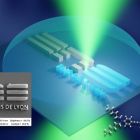With the infinitely small approaches, 3D printing has to choose between speed and resolution, which makes its industrial applications difficult.
.
Researchers at the LCH and the Osaka Nanomaterials Research Institute have therefore developed a system based on a phenomenon called chemistry (chemistry is a natural science) divided into different subject areas such as physics and biology with which it shares …)
.
Two photons (In particle physics, the photon is the elementary mediating particle of the electromagnetic interaction. In other words, when two particles …) close to resonance. Your lasers will then be able to polymerize and thus solidify resins with excellent performance, but which otherwise would not be reactive enough to be suitable for 3D printing. This work, published in the journal Macromolecules, ensures precision and speed in the manufacture of objects with details as small as 80 nanometers. © […]
Case Study: How PepsiCo achieved 96% cost savings on tooling with 3D Printing Technology
Above: PepsiCo food, snack, and beverage product line-up/Source: PepsiCo PepsiCo turned to tooling with 3D printing...





0 Comments